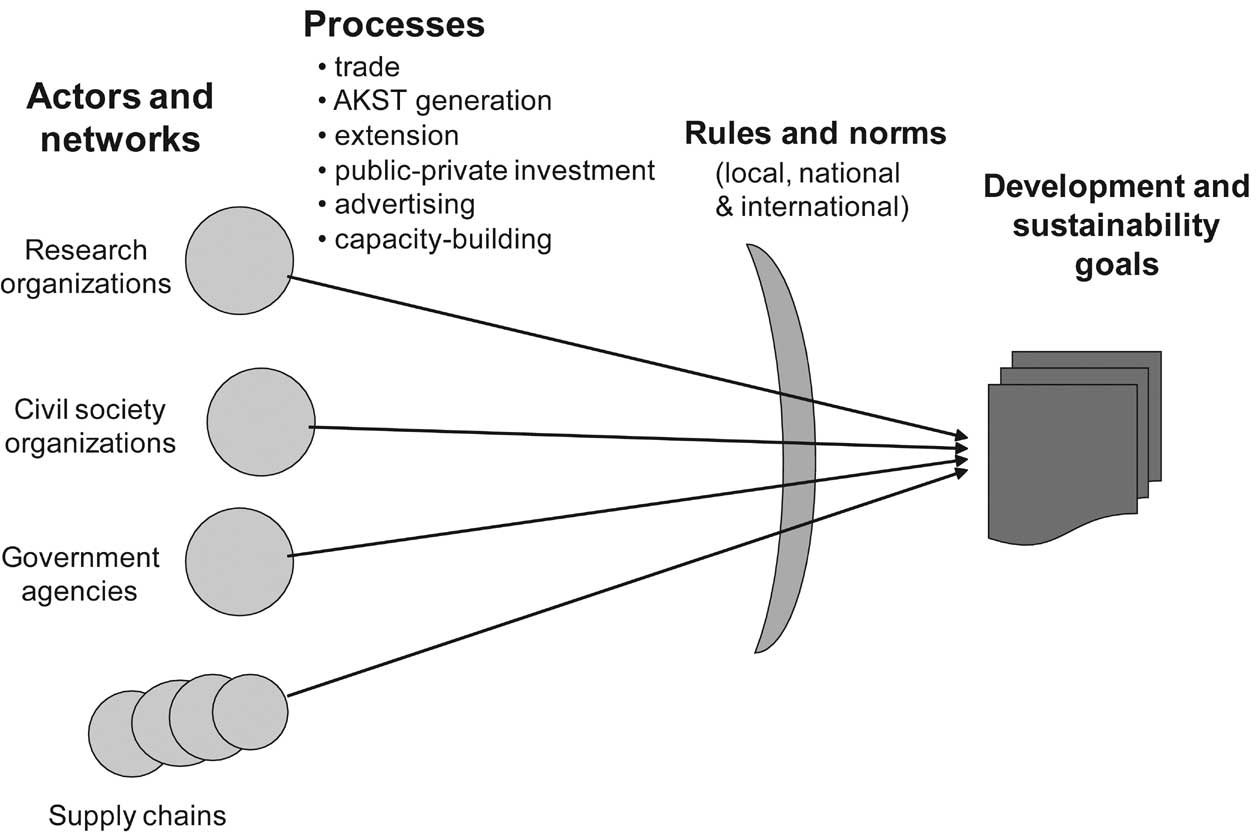
| Previous | Return to table of contents | Search Reports | Next |
| « Back to weltagrarbericht.de | ||
Setting the Stage | 5

Figure 1-3. AKST dynamics
their development and availability, access and use. They include knowledge and technology generation, dissemination and extension, adoption, and evaluation for all sectors in supply chains; trade; public-private investment; advertising; and provision of credit and other financial resources. Rules and norms are the sociocultural and legal conventions that manage and control AKST processes. They include international agreements and treaties, such as the International Treaty on Plant Genetic Resources for Food and Agriculture and the Convention on Biological Diversity; agreements related to trade, such as trade-related Intellectual Property Rights and World Trade Organization (WTO) settlements; international quality standards such as ISO14000 and the Codex Alimentarius; subsidies; national regulations; tax structures; and local customs. Many of the actors, rules and norms relevant to the development, distribution and use of AKST were established by World War II Allies in the post-war years. The United Nations (UN) and the World Bank were founded in 1945 to promote economic development and the avoidance of conflict; and the UN agencies Food and Agriculture Organization (FAO), United Nations Children's Fund (UNICEF) and the World Health Organization (WHO) were created shortly afterwards. International agricultural research stations were established during the 1960s, with support from the Rockefeller Foundation, and became the first centers of the new CGIAR in 1971. Discussions among wartime allies of the United States in the late 1940s to create a multilateral agreement for the reciprocal reduction of tariffs on trade in goods led to the General Agreement on Tariffs and Trade negotiation rounds and ultimately the WTO in 1995. |
|
1.2 Agriculture, development and sustainability goals 1.2.1 Eradicating hunger and food insecurity; providing adequate amounts of healthy, safe food; and improving human health The development and implementation of agricultural knowledge, science and technology have delivered real benefits in food availability worldwide. Few countries in NAE have large numbers of hungry and impoverished people, yet food insecurity is still present in all of them. For example, the United States (US) has the highest Gross Domestic Product of NAE countries; but 10.9% of the US population was food-insecure in 2006, meaning that they lacked access at all times to enough food for an active, healthy life for all household members; and 4% suffered from "very low food security," indicating that the food intake of one or more adults was reduced and their eating patterns were disrupted at times during the year because the household lacked money and other resources for food (Nord et al., 2007). Food insecurity in NAE is more frequently a consequence of poverty and specific government policies that fail to ensure access to available food than due to general lack of AKST, yet such policies are elements of agrifood systems, and can draw upon AKST. Advances in agricultural productivity have been uneven through NAE, and subsistence farming still predominates in parts of Eastern Europe, with high levels of food insecurity in some countries that have been torn by war or political instability or have been under Soviet influence. The FAO estimates that rates of food insecurity are no more than 6% in |
| Previous | Return to table of contents | Search Reports | Next |
| « Back to weltagrarbericht.de | ||